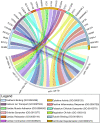Unraveling the role of miRNAs as biomarkers in Chagas cardiomyopathy: Insights into molecular pathophysiology
- PMID: 38300899
- PMCID: PMC10833550
- DOI: 10.1371/journal.pntd.0011865
Unraveling the role of miRNAs as biomarkers in Chagas cardiomyopathy: Insights into molecular pathophysiology
Abstract
Background: Chagas cardiomyopathy (ChCM) is a severe form of Chagas disease and a major cause of cardiovascular morbidity and mortality. The dysregulation of the immune response leads to cardiac remodeling and functional disruptions, resulting in life-threatening complications. Conventional diagnostic methods have limitations, and therapeutic response evaluation is challenging. MicroRNAs (miRNAs), important regulators of gene expression, show potential as biomarkers for diagnosis and prognosis.
Aim: This review aims to summarize experimental findings on miRNA expression in ChCM and explore the potential of these miRNAs as biomarkers of Chagas disease.
Methods: The search was conducted in the US National Library of Medicine MEDLINE/PubMed public database using the terms "Chagas cardiomyopathy" OR "Chagas disease" AND "microRNA" OR "miRNA" OR "miR." Additionally, bioinformatics analysis was performed to investigate miRNA-target interactions and explore enrichment pathways of gene ontology biological processes and molecular functions.
Results: The miR-21, miR-146b, miR-146a, and miR-155 consistently exhibited up-regulation, whereas miR-145 was down-regulated in ChCM. These specific miRNAs have been linked to fibrosis, immune response, and inflammatory processes in heart tissue. Moreover, the findings from various studies indicate that these miRNAs have the potential as biomarkers for the disease and could be targeted in therapeutic strategies for ChCM.
Conclusion: In this review, we point out miR-21, miR-146b, miR-146a, miR-155, and miR-145-5p role in the complex mechanisms of ChCM. These miRNAs have been shown as potential biomarkers for precise diagnosis, reliable prognostic evaluation, and effective treatment strategies in the ChCM.
Copyright: © 2024 Ribeiro et al. This is an open access article distributed under the terms of the Creative Commons Attribution License, which permits unrestricted use, distribution, and reproduction in any medium, provided the original author and source are credited.
Conflict of interest statement
The authors have declared that no competing interests exist.
Figures




References
Publication types
MeSH terms
Substances
LinkOut - more resources
Full Text Sources
Medical

